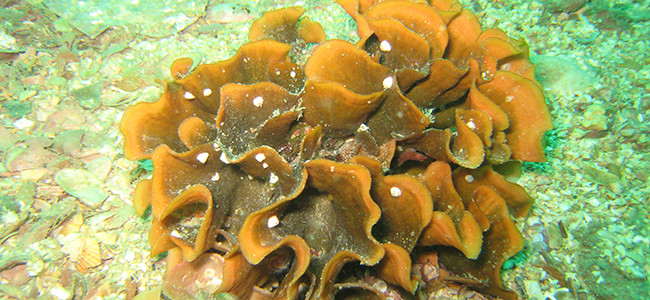Pentapora fascialis is a species of bryozoan belonging to the family Hippoporidridae, in the order Cheilostomatida. The scientific name of this species derives from the Latin ‘penta‘ meaning five, referring to the pentagonal shape often adopted by its colony, and ‘pora‘ which refers to the pores or openings through which its individuals feed. The term ‘fascialis‘ likely alludes to the bands or structures observed on its surface. It does not have a widely recognized common name, but it is sometimes referred to as the ‘lace bryozoan‘ due to its net-like structure. It is mainly found in the northeastern Atlantic, including the coasts of the United Kingdom, Ireland, France, Spain, and Portugal, as well as in the Mediterranean Sea. It typically inhabits hard-bottom areas, such as rocks or coral substrates, at depths ranging from 10 to 100 meters.
Pentapora fascialis forms large colonies that can reach up to 1 meter in diameter and 30 centimeters in height. The colonies have a fan-shaped or lace-like structure, with fine, interwoven branches that give them a delicate yet resilient appearance. Their coloration ranges from orange to yellowish, making them stand out on the seafloor, unlike many other bryozoan species which tend to be more dull-colored. A distinctive morphological feature of Pentapora fascialis is the presence of lobes or ridges on the colonies, which aid in their identification. Compared to similar species such as Myriapora truncata, which also has a branched structure, Pentapora fascialis is distinguished by its larger size and the more open, less compact arrangement of its branches.
In terms of feeding, Pentapora fascialis is a filter feeder. It feeds on suspended particles in the water, mainly plankton and organic matter. Each individual within the colony, known as a zooid, possesses filaments called lophophores, which are used to trap small food particles. The efficiency of its feeding depends on water movement, so it is commonly found in areas with moderate currents that ensure a constant supply of nutrients.
The reproduction of Pentapora fascialis is both sexual and asexual. During sexual reproduction, the zooids release gametes into the water, where fertilization occurs. The resulting larvae disperse through the water column until they settle on a suitable substrate, where they begin to form new colonies. Asexual reproduction occurs through budding, which allows the colony to grow rapidly and repair damage to its structure. This reproductive cycle is usually continuous, without a clearly defined breeding season, although reproductive activity may increase during the warmer months of the year.
An interesting fact about Pentapora fascialis is that, due to its large size and three-dimensional structure, it provides shelter and habitat for many other marine species, such as small invertebrates and juvenile fish, increasing local biodiversity. It has also been observed that some organisms, such as sea urchins, sometimes interact with Pentapora fascialis colonies, affecting their structure by grazing on them. Although no obligatory symbiotic relationship is known, this species plays an important role in benthic ecosystems by providing a structured microhabitat.
Photos:

